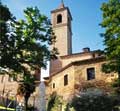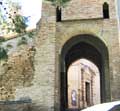Fairs and events in the medieval village of Saludecio
Beaches
Fun and Nightlife
Visit Cattolica
- The history of Cattolica and its traditions
- The town hall
- The dancing fountains of 1° Maggio square
- The town centre
- The historical centre
- The Regina museum
- The Market square
- The multi-cultural centre
- The Regina theatre
- The churches
- The walk along via Dante
- The beach and the sea front
- The harbour
- The water park "Le Navi"
Inland
Search on cattolica hotel
Saludecio

History and origins
Tradition is to trace the origin of Saludecio to Trajan Decius, Roman emperor, which was found
lobster on the hills, building the home. Hence "salus Decii" or "saltus Decii".
Another hypothesis to consider nineteenth Saludecio name derived from the holder of the old Holy
Parish: St. Latakia, which appears as a vulgar Sanlodeccio in a novella of the Decameron. "
At the end of'200 takes shape the process of militarization of space, which will further
developments over the centuries XIV and XV, when the town of Rimini took over the Signoria Malatesta.
Throughout the fifteenth century, the country's history is intertwined with power struggles between the two most
famous and illustrious contenders: Sigismondo Malatesta and Federico da Montefeltro.
In 1469 the castle was taken by Roberto, son of Sigismund, and then in 1482 by Pandolfo, son of
Roberto, he is lost at the hands of the Venetians. After the brief rule of the Republic of Venice,
Saludecio for a few years back to the town of Rimini.
From 1517 come under the jurisdiction of Francesco Maria Della Rovere and then finally come to
be part of the Papal States by 1524.
In the second half of'700, even here, as throughout the Papal States, one begins to feel the
hardship due to financial crisis, the lack of economic and political reforms, all compounded
the famine of 1776 and the earthquake of 1786.
Saludecio, appointed after June 24 1859 the Provisional Junta of Government, becomes the
proclamation of the Kingdom of Italy, the capital mandated by the Valconca.

Places to visit
The city wall ramparts, which spread around the country, defines the core historic medieval largely
restored, has defensive ramparts of various types due to different periods (sec. XV / XVI).
The Church, with the adjoining complex is located in the upper part of the village. Founded in 1640 by Blessed
Cyprian Mosconi the order of friars Gerolomini, retains a number of eighteenth century paintings and an altar of wood
finely carved. Also noteworthy is the Cloister of the Convent in part restructured. Porta Marina. Facing the Adriatic
Sea, is the main access to the country (XIV century) and is characterized by the municipal coat of arms displayed
over the input: entering, on the right, you can enjoy the tombstone sandstone (XVI century) and Publio Francesco
Modesti renowned humanist scholar, devoted the origins of Saludecio. Montanara door. Facing the Apennine foothills,
is the second gateway to the village (XIV century). The Church is also the Shrine of Blessed Amato Ronconi, which
miraculously keeps the body in a glass urn, an exceptionally documentary and artistic value the rich heritage of
ex-votos collected over the centuries around the cult of the Blessed. Olmo del Beato. Chapel in which it keeps the
old elm by Beato Amato, a relic which is linked to the popular tradition and religious the Franciscan Amato Ronconi,
who lived in the thirteenth century. In the same building is a bronze of the blessed, attributed to Prospero Clementi
(1516-1584). In the first week of August takes place the 800 Festival Saludecio, a large event, including
shows, exhibitions and markets evokes the lively atmosphere of the nineteenth century operetta.
Video
Links
Weather Forecast

Want to know the weather forecast in the coming days?
Visit the weather section.
Sponsor Hotels
 Deutsch
Deutsch English
English
 Francais
Francais Italiano
Italiano


